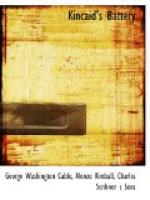In those days New Orleans paved her favorite streets, when she paved them at all, with big blocks of granite two feet by one. They came from the North as ballast in those innumerable wide-armed ships whose cloud of masts and cordage inspiringly darkened the sky of that far-winding river-front where we lately saw Hilary Kincaid and Fred Greenleaf ride. Beginning at the great steamboat landing, half a mile of Canal Street had such a pavement on either side of its broad grassy “neutral ground.” So had the main streets that led from it at right angles. Long afterward, even as late as when the Nineteenth Century died, some of those streets were at the funeral, clad in those same old pavements, worn as smooth and ragged as a gentleman-beggar’s coat. St. Charles Street was one. Another was the old Rue Royale, its squat ground-floor domiciles drooping their mossy eaves half across the pinched sidewalks and confusedly trying to alternate and align themselves with tall brick houses and shops whose ample two-and three-story balconies were upheld, balustraded, and overhung by slender garlandries of iron openwork as graceful and feminine as a lace mantilla. With here and there the flag of a foreign consul hanging out and down, such is the attire the old street was vain of in that golden time when a large square sign on every telegraph pole bade you get your shirts at S.N. Moody’s, corner of Canal and Royal Streets.
At this corner, on the day after the serenade, there was a dense, waiting crowd. On the other corner of Royal, where the show-windows of Hyde & Goodrich blazed with diamonds, and their loftily nested gold pelican forever fed her young from her bleeding breast, stood an equal throng. Across Canal Street, where St. Charles opens narrowly southward, were similar masses, and midway between the four corners the rising circles of stone steps about the high bronze figure of Henry Clay were hidden by men and boys packed as close as they could sit or stand. A great procession had gone up-town and would by and by return. Near and far banners and pennons rose and fell on the luxurious air, and the ranks and ranks of broad and narrow balconies were so many gardens of dames and girls, parasols, and diaphanous gowns. Near the front of the lowest Hyde & Goodrich balcony, close by the gilded pelican, sat the Callenders, all gladness, holding mute dialogues with Flora and Madame Valcour here on the balcony of Moody’s corner. It was the birthday of Washington.
Not of him, however, did Flora and her grandmother softly converse in Spanish amid the surrounding babel of English and French. Their theme was our battery drill of some ten days before, a subject urged upon Flora by the mosquito-like probings of Madame’s musically whined queries. Better to be bled of almost any information by the antique little dame than to have her light on it some other way, as she had an amazing knack of doing. Her acted part of things Flora kept untold; but grandma’s spirit of divination could unfailingly supply that, and her pencilled brows, stiff as they were, could tell the narrator she had done so.




